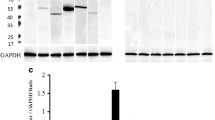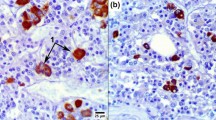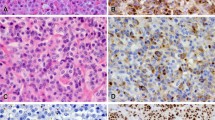Summary
The phenomenon of crinophagy in rat pituitary mammotrophs, or lysosomal uptake of prolactin secretory granules, was confirmed by means of double-label immunogold electron microscopy, and shown to be induced in estrogen-stimulated male rats. Rabbit antibodies to rat cathepsin D were used to label lysosomes, and to rat prolactin to label secretory granules. The pituitaries were fixed in 4% formaldehyde and 1% glutaraldehyde, embedded in Lowicryl K4M, and thin sections were exposed successively to primary antibodies, biotin-labelled second antibodies, and streptavidin-gold, with an amplification procedure for cathepsin D. Cathepsin D and prolactin were detected separately on opposite sides of the sections, using 5-nm and 15-nm gold particles. Lysosomal uptake of prolactin secretory granules was not observed in untreated control rats. It was detected in about 26% of lysosome-containing mammotroph cell sections in estrogen-stimulated rats and at 7 h after estrogen withdrawal, but fell to 14% at 24 h and to 2% at 72 h after estrogen withdrawal.
Similar content being viewed by others
References
Afting EG, Becker ML (1981) Two-step affinity-chromatographic purification of cathepsin D from pig myometrium with high yield. Biochem J 197:519–522
Barrett AJ (1977) Cathepsin D and other carboxyl proteinases. In: Barrett AJ (ed) Proteinases in mammalian cells and tissues. North Holland, Amsterdam, pp 209–248
Bendayan M (1982) Double immunocytochemical labelling applying the protein A-gold technique. J Histochem Cytochem 30:81–85
Bendayan M, Duhr MA (1986) Modification of the protein A-gold immunocytochemical technique for the enhancement of its efficiency. J Histochem Cytochem 34:569–575
Bendayan M, Maestracci ND (1984) Pituitary adenomas: patterns of hPRL and hGH secretion as revealed by high resolution immunocytochemistry. Biol Cell 52:129–138
Bernstein HG, Kirschke H, Wiederanders B, Müller A, Rinne A, Dorn A (1987) Cathepsin D, B, and H in rat brain as demonstrated by immunohistochemistry. Acta Histochem 82:25–27
Carlemalm, E, Garavito RM, Villiger W (1972) Resin development for electron microscopy and an analysis of embedding at low temperature. J Microsc 126:123–143
Chertow BS (1981) The role of lysosomes and proteases in hormone secrction and degradation. Endocr Rev 2:137–173
Day RN, Hinkle PM (1988) Osinotic regulation of prolactin secretion. Possible role of chloride. J Biol Chem 263:15915–15921
Decker RS, Poole AR, Wildenthal K (1980) Distribution of lysosomal cathepsin D in normal, ischemic and starved rabbit cardiac myocytes. Circ Res 46:485–494
DeMarco I, Mashiter K, Peters TJ (1982) Suckling withdrawal increases pituitary lysosomal enzyme activities and prolactin protease in lactating rats. Endocrinology 110:1178–1182
Farquhar M (1977) Secretion and crinophagy in prolactin cells. Adv Exp Med Biol 80:37–46
Landstrom AS (1987) A role for crinophagy in pancreatic islet B cells. Ups J Med Sci 92:99–113
Maldonado CA, Aoki A (1986) Influence of embedding media in prolactin labelling with immunogold technique. Histochem J 18:429–433
McLean IW, Nakane PK (1974) Periodate-lysine paraformaldehyde fixative, a new fixative for immunoelectron microscopy. J Histochem Cytochem 22:1077–1083
Morin A, Rosenbaum E, Tixier-Vidal A (1984) Effects of thyrotropin-releasing hormone on prolactin compartments in normal rat pituitary cells in primary culture. Endocrinology 115:2278–2284
Nikitovitch-Winer MB, Atkin J, Maley BE (1987) Colocalization of prolactin and growth hormone within specific adenohypophyseal cells in male, female, and lactating female rats. Endocrinology 121:625–630
Nishimura Y, Higaki M, Kato K (1987) Identification of a precursor form of cathepsin D in microsomal lumen: characterization of enzymatic activation and proteolytic processing in vitro. Biochem Biophys Res Commun 148:335–343
Papas S, Shin SH, Obonsawin MC (1988) Bovine “Neurophysin II’ stimulates growth hormone release in the estradiol-primed male rat. Neuroendocrinology 47:154–158
Piercy M, Shin SH (1980) Comparative studies of prolactin secretion in estradiol-primed and normal male rats induced by ether stress, pimozide and TRH. Neuroendocrinology 31:270–275
Samarel AM, Worobec SW, Ferguson AG, Decker RS, Lesch M (1986) Limited proteolysis of rabbit procathepsin D in a cell-free system. Am J Physiol 250:C589-C596
Schnell AH, Swenne I, Borg LA (1988) Lysosomes and pancreatic islet function. A quantitative estimation of crinophagy in the mouse pancreatic B-cell. Cell Tissue Res 252:9–15
Smith RE, Farquhar MG (1966) Lysosome function in the regulation of the secretory process in cells of the anterior pituitary gland. J Cell Biol 31:319–347
Snyder DS, Simonis S, Uzman BG, Whitaker JN (1985) Rat neural tissue cathepsin D: ultrastructural immunocytochemistry. J Neurol 14:579–596
Stokreef JC, Reifel CW, Shin SH (1986) A possible phagocytic role for follicular-stellate cells of anterior pituitary following estrogen withdrawal from primed male rats. Cell Tissue Res 243:255–261
Torres AI, Haggi ES, Aoki A (1984) Isolation of two different pools of pituitary prolactin. Acta Endocrinol 107:25–30
Tougard C, Picart R (1986) Use of pre-embedding ultrastructural immunocytochemistry in the localization of a secretory product and membrane proteins in cultured prolactin cells. Am J Anat 175:161–177
Van Loon GR, Shum A, George SR, Shin SH (1983) Prolactin increases the activity of tuberoinfundibular and nigroneostriatal dopamine neurones: prolactin antiserum inhibits the haloperidol induced increases in dopamine synthesis rates in median eminence and striatum of rats. Brain Res Bull 10:539–545
Walker AM, Farquhar MG (1980) Preferential release of newly synthesized prolactin granules is the result of functional heterogeneity among mammotrophs. Endocrinology 107:1095–1104
Wiederanders B, Kirschke H (1986) Antibodies to rat liver cathepsins: characterization and use for the identification of enzyme precursors. Biomed Biochim Acta 45:1421–1431
Yokota S, Tsuji H, Kato K (1985) Localization of cathepsin D in rat liver. Immunocytochemical study using post-embedding immunoenzyme and protein A-gold techniques. Histochemistry 82:141–148
Yonezawa S, Tanaka T, Miyauchi T (1987) Cathepsin E from rat neutrophils. Its properties and possible relations to cathepsin D-like and cathepsin E-like acid proteases. Arch Biochem Biophys 256:499–508
Author information
Authors and Affiliations
Rights and permissions
About this article
Cite this article
Kuriakose, N.R., Reifel, C.W., Bendavan, M. et al. Prolactin crinophagy is induced in the estrogen-stimulated male rat pituitary. Histochemistry 92, 499–503 (1989). https://doi.org/10.1007/BF00524761
Accepted:
Issue Date:
DOI: https://doi.org/10.1007/BF00524761




